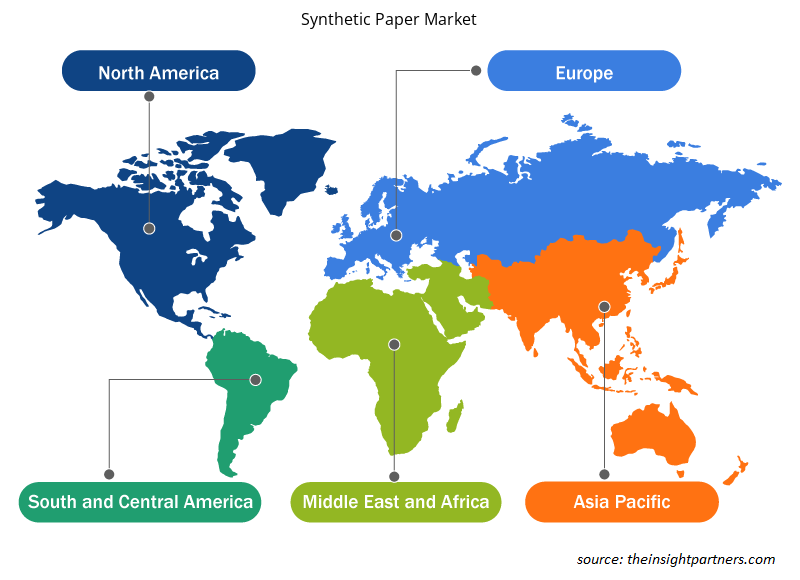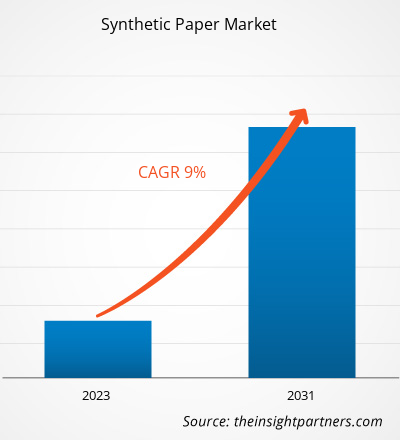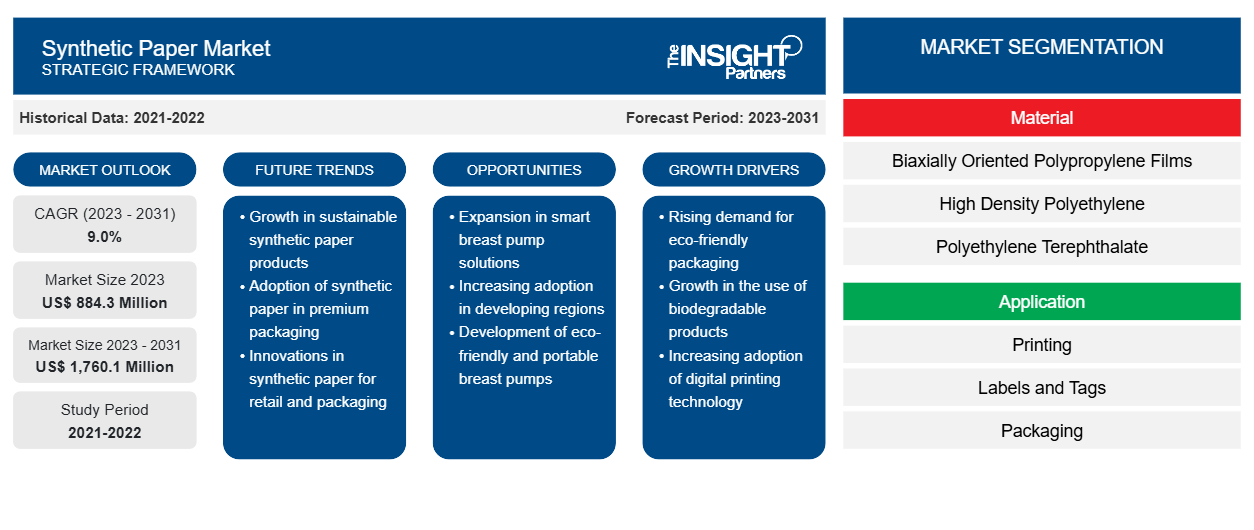Si prevede che la dimensione del mercato della carta sintetica raggiungerà 1.760,1 milioni di dollari entro il 2031, rispetto agli 884,3 milioni di dollari del 2023. Si prevede che il mercato registrerà un CAGR del 9,0% nel 2023-2031. È probabile che la crescente domanda da parte dei settori dell'imballaggio e della stampa rimanga una tendenza chiave del mercato della carta sintetica.
Analisi del mercato della carta sintetica
La domanda di carta sintetica nel settore degli imballaggi è in crescita grazie alla sua superiore durata e ai vantaggi ambientali. A differenza della carta tradizionale, la carta sintetica è altamente resistente all'acqua, alle sostanze chimiche e allo strappo, il che la rende una scelta ideale per gli imballaggi che devono resistere a condizioni difficili durante il trasporto e lo stoccaggio. Questa durata garantisce che l'imballaggio rimanga intatto e leggibile, preservando l'integrità del prodotto e migliorando la soddisfazione del cliente. Inoltre, la resistenza della carta sintetica ai fattori esterni riduce significativamente il rischio di danni, portando a risparmi sui costi nelle sostituzioni degli imballaggi e migliorando l'efficienza complessiva della catena di fornitura.
Panoramica del mercato della carta sintetica
Il mercato della carta sintetica sta vivendo una significativa combinazione di crescita guidata dalle sue proprietà uniche del materiale, dai vantaggi ambientali e dalle applicazioni in espansione in vari settori. La sua resistenza allo strappo, all'acqua, alle sostanze chimiche e alle temperature estreme rende la carta sintetica ideale per applicazioni in cui longevità e resilienza sono cruciali. Ciò è particolarmente vantaggioso in settori come la stampa, l'etichettatura e la pubblicità esterna , in cui i materiali sono spesso esposti a condizioni difficili. Ad esempio, gli istituti scolastici e le aziende apprezzano la carta sintetica per la produzione di manuali e materiali promozionali durevoli, mentre gli inserzionisti esterni si affidano alla sua capacità di mantenere colori vivaci e integrità strutturale sotto stress meteorologico.
Personalizza questo report in base alle tue esigenze
Riceverai la personalizzazione gratuita di qualsiasi report, comprese parti di questo report, o analisi a livello nazionale, pacchetto dati Excel, oltre a usufruire di grandi offerte e sconti per start-up e università
-
Scopri le principali tendenze di mercato in questo rapporto.Questo campione GRATUITO includerà analisi di dati che spaziano dalle tendenze di mercato alle stime e alle previsioni.
Driver e opportunità del mercato della carta sintetica
La crescente domanda per l'industria degli imballaggi rafforza la crescita del mercato della carta sintetica
La crescente domanda da parte dell'industria della stampa è un fattore determinante del mercato, alimentato dalla necessità di materiali stampati di alta qualità e durevoli. A differenza della carta tradizionale, la carta sintetica consente colori vivaci e immagini nitide, essenziali per creare prodotti stampati visivamente accattivanti e dall'aspetto professionale. Questa elevata qualità di stampa è particolarmente importante per materiali promozionali, brochure, biglietti da visita e altri materiali di marketing collaterali in cui la prima impressione è importante. Poiché le aziende cercano di migliorare i propri sforzi di branding e comunicazione, la capacità di produrre stampe ad alta risoluzione ed esteticamente gradevoli su carta sintetica è un vantaggio importante. La durata è un altro fattore cruciale che guida la domanda di carta sintetica nell'industria della stampa. I materiali stampati spesso devono resistere a frequenti manipolazioni, esposizione all'umidità e altre condizioni difficili senza degradarsi. La resistenza della carta sintetica a strappi, acqua e sostanze chimiche garantisce che i documenti stampati rimangano intatti e leggibili nel tempo. Ciò è particolarmente prezioso per prodotti come menu, manuali, mappe e materiali didattici soggetti a un uso intenso. La durata della carta sintetica riduce la necessità di frequenti sostituzioni, con conseguenti risparmi sui costi per aziende e istituzioni che si affidano a materiali stampati. Questa qualità duratura rende la carta sintetica la scelta preferita per numerose applicazioni di stampa.
Maggiore attenzione alla sostenibilità ambientale
La crescente attenzione alla sostenibilità ambientale è un fattore importante della domanda di carta sintetica, poiché aziende e consumatori diventano più consapevoli del loro impatto ecologico. A differenza della carta tradizionale, che comporta deforestazione e un elevato consumo di acqua durante la produzione, la carta sintetica è realizzata in polipropilene o polietilene, che sono completamente riciclabili. Ciò significa che la carta sintetica può essere riprocessata e riutilizzata, riducendo gli sprechi e preservando le risorse naturali. Le aziende che mirano a migliorare le proprie pratiche di sostenibilità stanno sempre più optando per la carta sintetica per allinearsi ai propri obiettivi ambientali, guidando così la crescita del mercato.
Analisi della segmentazione del rapporto di mercato della carta sintetica
I segmenti chiave che hanno contribuito alla derivazione dell'analisi di mercato della carta sintetica sono il materiale e l'applicazione.
- In base al materiale, il mercato è segmentato in film di polipropilene biassialmente orientati (BOPP), polietilene ad alta densità (HDPE), polietilene tereftalato (PET), cloruro di polivinile (PVC) e altri. Il segmento dei film di polipropilene biassialmente orientati (BOPP) ha detenuto una quota di mercato maggiore nel 2023.
- In termini di applicazione, il mercato è segmentato in stampa, etichette e cartellini, imballaggi e altri. Il segmento della stampa ha detenuto la quota maggiore del mercato nel 2023.
Analisi della quota di mercato della carta sintetica per area geografica
L'ambito geografico del rapporto sul mercato della carta sintetica è suddiviso principalmente in cinque regioni: Nord America, Asia Pacifico, Europa, Medio Oriente e Africa, Sud e Centro America.
La regione Asia-Pacifico sta vivendo una crescita significativa dovuta a una combinazione di crescita economica, espansione industriale e crescente domanda di materiali durevoli e di alta qualità. La solida base industriale in Cina, Giappone e India è un fattore significativo che guida la crescita del mercato. Questi paesi si sono affermati come potenze manifatturiere, producendo un'ampia gamma di beni che richiedono soluzioni di etichettatura, imballaggio e stampa affidabili e durevoli . La carta sintetica, con la sua superiore resistenza allo strappo, all'umidità e alle sostanze chimiche, soddisfa queste esigenze, guidando efficacemente una domanda significativa nel settore industriale. Inoltre, l'urbanizzazione e l'aumento del reddito disponibile hanno portato a un aumento del consumo di beni di consumo, che a sua volta aumenta la domanda di soluzioni di imballaggio avanzate. L'e-commerce, che ha visto una crescita esplosiva nella regione, amplifica ulteriormente questa esigenza. La carta sintetica è molto apprezzata negli imballaggi per la sua integrità e aspetto in varie condizioni, rendendola una scelta ideale per scopi di vendita al dettaglio e spedizione. La durata e la qualità di stampa della carta sintetica migliorano la presentazione del prodotto e la visibilità del marchio, il che è fondamentale in un mercato competitivo.
Approfondimenti regionali sul mercato della carta sintetica
Le tendenze regionali e i fattori che influenzano il mercato della carta sintetica durante il periodo di previsione sono stati ampiamente spiegati dagli analisti di Insight Partners. Questa sezione discute anche i segmenti e la geografia del mercato della carta sintetica in Nord America, Europa, Asia Pacifico, Medio Oriente e Africa e America meridionale e centrale.

- Ottieni i dati specifici regionali per il mercato della carta sintetica
Ambito del rapporto sul mercato della carta sintetica
| Attributo del report | Dettagli |
|---|---|
| Dimensioni del mercato nel 2023 | 884,3 milioni di dollari USA |
| Dimensioni del mercato entro il 2031 | 1.760,1 milioni di dollari USA |
| CAGR globale (2023-2031) | 9,0% |
| Dati storici | 2021-2022 |
| Periodo di previsione | 2023-2031 |
| Segmenti coperti |
Per materiale
|
| Regioni e Paesi coperti |
America del Nord
|
| Leader di mercato e profili aziendali chiave |
|
Densità degli attori del mercato della carta sintetica: comprendere il suo impatto sulle dinamiche aziendali
Il mercato della carta sintetica sta crescendo rapidamente, spinto dalla crescente domanda degli utenti finali dovuta a fattori quali l'evoluzione delle preferenze dei consumatori, i progressi tecnologici e una maggiore consapevolezza dei vantaggi del prodotto. Con l'aumento della domanda, le aziende stanno ampliando le loro offerte, innovando per soddisfare le esigenze dei consumatori e capitalizzando sulle tendenze emergenti, il che alimenta ulteriormente la crescita del mercato.
La densità degli operatori di mercato si riferisce alla distribuzione di aziende o società che operano in un particolare mercato o settore. Indica quanti concorrenti (operatori di mercato) sono presenti in un dato spazio di mercato in relazione alle sue dimensioni o al valore di mercato totale.
Le principali aziende che operano nel mercato della carta sintetica sono:
- Cosmo Films Ltd.
- NAGASE (EUROPA) GmbH
- Materiali di imballaggio IPP
- Arjobex SAS
- PPG Industries, Inc
- Avery Dennison Corp
Disclaimer : le aziende elencate sopra non sono classificate secondo un ordine particolare.

- Ottieni una panoramica dei principali attori del mercato della carta sintetica
Notizie e sviluppi recenti sul mercato della carta sintetica
Il mercato della carta sintetica viene valutato raccogliendo dati qualitativi e quantitativi dopo la ricerca primaria e secondaria, che include importanti pubblicazioni aziendali, dati associativi e database. Di seguito è riportato un elenco degli sviluppi nel mercato della carta sintetica e delle strategie:
- Oggi, Agfa annuncia il lancio sul mercato della sua carta sintetica SYNAPS Xerographic Matt (XM) che include un agente che antagonizza l'insediamento e la crescita di batteri e virus sulla sua superficie. L'agente rimane attivo per l'intera durata della carta sintetica e protegge anche le aree di stampa coperte di inchiostro toner. La sua efficienza fino al 99,99% è stata dimostrata attraverso test indipendenti ISO 20743 e ISO 18184. Questo nuovo tipo di SYNAPS XM sostituisce la gamma di prodotti XM esistente preservandone completamente l'eccellente qualità di stampa, il comportamento di processo antistatico e la compatibilità universale con le stampanti. (Fonte: Agfa-Gevaert Group, comunicato stampa, 2021)
Copertura e risultati del rapporto sul mercato della carta sintetica
Il rapporto "Dimensioni e previsioni del mercato della carta sintetica (2021-2031)" fornisce un'analisi dettagliata del mercato che copre le seguenti aree:
- Dimensioni e previsioni del mercato a livello globale, regionale e nazionale per tutti i segmenti di mercato chiave coperti dall'ambito
- Dinamiche di mercato come fattori trainanti, vincoli e opportunità chiave
- Principali tendenze future
- Analisi dettagliata delle cinque forze di Porter e SWOT
- Analisi di mercato globale e regionale che copre le principali tendenze di mercato, i principali attori, le normative e gli sviluppi recenti del mercato
- Analisi del panorama industriale e della concorrenza che copre la concentrazione del mercato, l'analisi della mappa di calore, i principali attori e gli sviluppi recenti
- Profili aziendali dettagliati
- Analisi storica (2 anni), anno base, previsione (7 anni) con CAGR
- Analisi PEST e SWOT
- Valore/volume delle dimensioni del mercato - Globale, Regionale, Nazionale
- Industria e panorama competitivo
- Set di dati Excel
Report recenti
Rapporti correlati
Testimonianze
Motivo dell'acquisto
- Processo decisionale informato
- Comprensione delle dinamiche di mercato
- Analisi competitiva
- Analisi dei clienti
- Previsioni di mercato
- Mitigazione del rischio
- Pianificazione strategica
- Giustificazione degli investimenti
- Identificazione dei mercati emergenti
- Miglioramento delle strategie di marketing
- Aumento dell'efficienza operativa
- Allineamento alle tendenze normative























 Ottieni un campione gratuito per - Mercato della carta sintetica
Ottieni un campione gratuito per - Mercato della carta sintetica